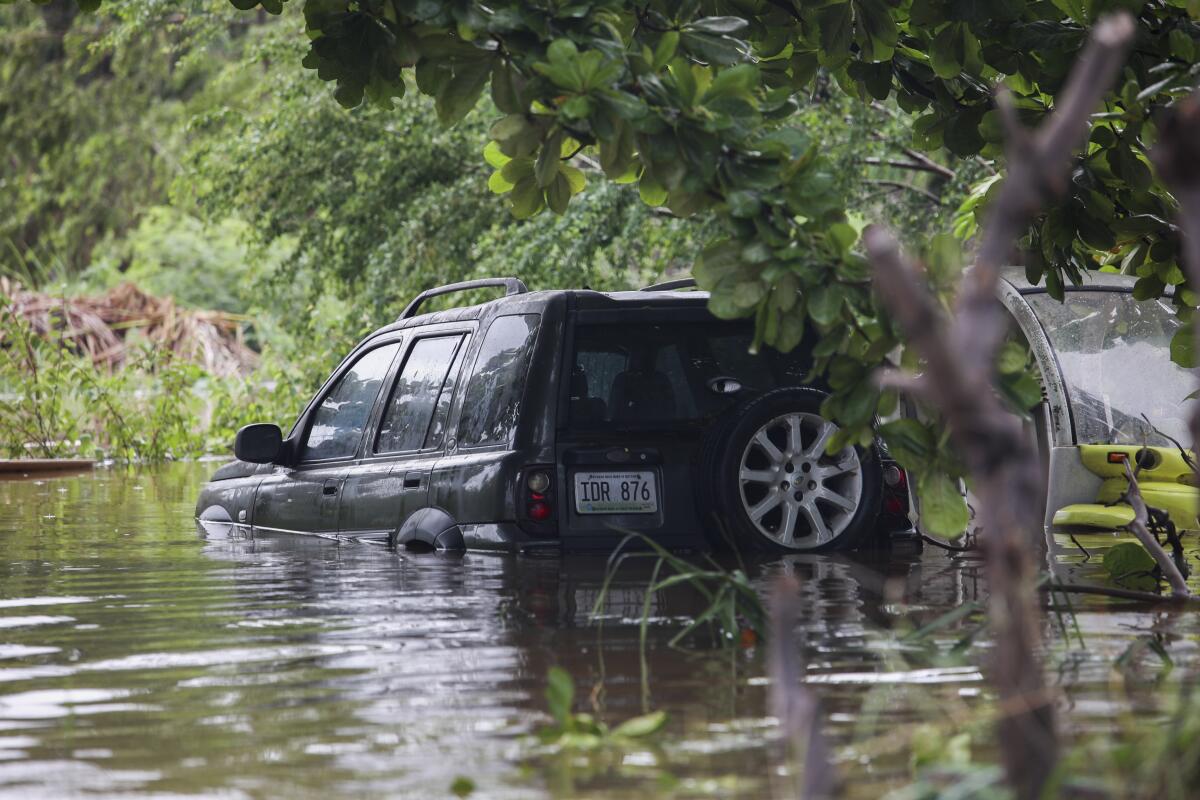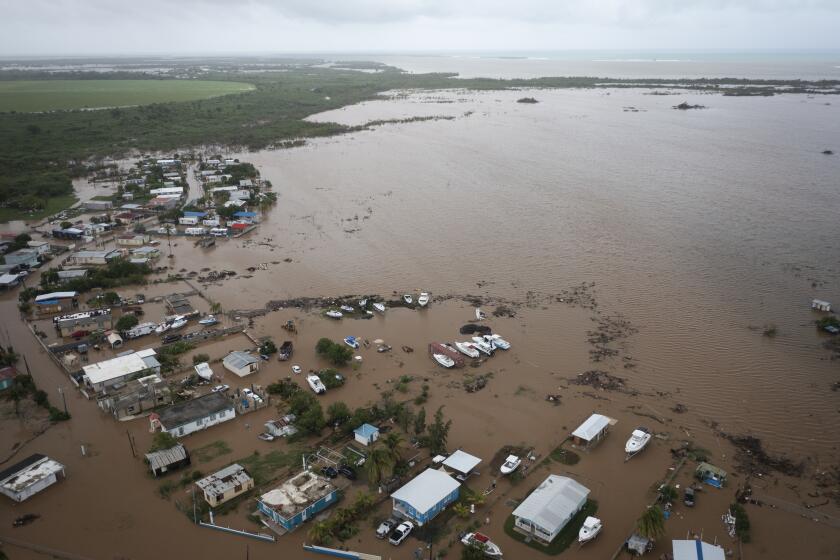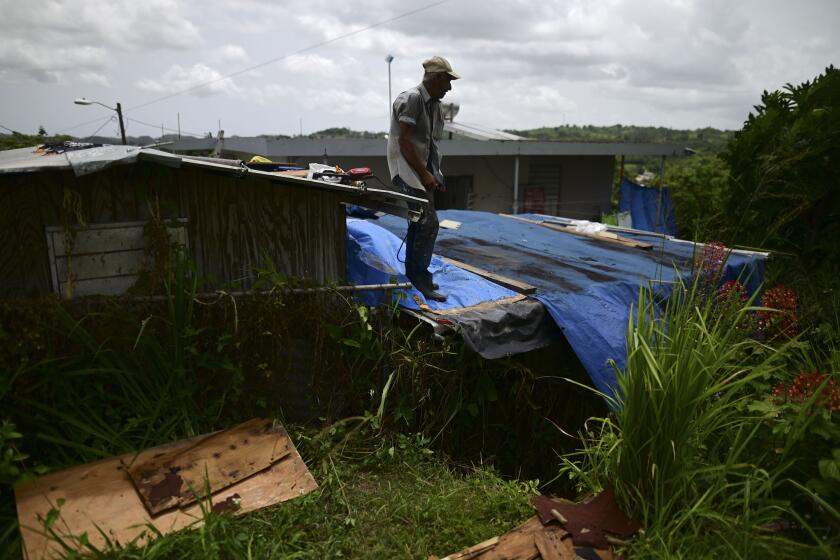Fiona swipes Turks and Caicos; Puerto Rico faces big cleanup

- Share via
CAYEY, Puerto Rico — Hurricane Fiona blasted the Turks and Caicos Islands on Tuesday as a Category 3 storm after devastating Puerto Rico, where most people remained without electricity or running water and rescuers used heavy equipment to lift survivors to safety.
The storm’s eye passed close to Grand Turk, the small British territory’s capital island, on Tuesday morning after the government imposed a curfew and urged people to flee flood-prone areas. Storm surge could raise water levels there by as much as 5 to 8 feet above normal, according to the U.S. National Hurricane Center.
Late Tuesday afternoon, the storm was centered about 50 miles north of North Caicos Island, with hurricane-force winds extending up to 30 miles from the center.
Premier Washington Misick urged people to evacuate. “Storms are unpredictable,” he said in a statement from London, where he had attended the funeral of Queen Elizabeth II. “You must therefore take every precaution to ensure your safety.”
Fiona had maximum sustained winds of 115 mph and was moving north-northwest at 8 mph, according to the U.S. National Hurricane Center, which said the storm was likely to strengthen further into a Category 4 hurricane as it approaches Bermuda on Friday.
Rain was still lashing parts of the U.S. territory of Puerto Rico on Tuesday, where the sounds of people scraping, sweeping and spraying their homes and streets echoed across rural areas as historic floodwaters began to recede.
Community organizations in Puerto Rico need aid after enduring Hurricane Fiona
In the central mountain town of Cayey, where the Plato River burst its banks and the brown torrent of water consumed cars and homes, overturned dressers, beds and large refrigerators lay strewn in people’s yards Tuesday.
“Puerto Rico is not prepared for this, or for anything,” said Mariangy Hernández, a 48-year-old homemaker, who said she doubted the government would help her community of some 300 in the long term, despite ongoing efforts to clear the streets and restore power. “This is only for a couple of days and later they forget about us.”
She and her husband were stuck in line waiting for the National Guard to clear a landslide in their hilly neighborhood.
“Is it open? Is it open?” one driver asked, worried that the road might have been completely closed.
Other drivers asked the National Guard if they could swing by their homes to help cut trees or clear clumps of mud and debris.
The cleanup efforts occurred on the fifth anniversary of Hurricane Maria, which hit as a Category 4 storm in 2017 and knocked out power for a year in parts of Cayey.
Jeannette Soto, a 34-year-old manicurist, worried it would take a long time for crews to restore power because a landslide swept away the neighborhood’s main light post.
“It’s the first time this happens,” she said of the landslides. “We didn’t think the magnitude of the rain was going to be so great.”
Gov. Pedro Pierluisi requested a major disaster declaration on Tuesday and said it would be at least a week before authorities have an estimate of the damage that Fiona caused.
He said the damage caused by the rain was “catastrophic,” especially in the island’s central, south and southeast regions.
“The impact caused by the hurricane has been devastating for many people,” he said.
The head of the Federal Emergency Management Agency traveled to Puerto Rico on Tuesday as the agency announced it was sending hundreds of additional personnel to boost local response efforts.
The broad storm kept dropping copious amounts of rain over the Dominican Republic and Puerto Rico, where a 58-year-old man died after he was swept away by a river in the central mountain town of Comerio, police said.
Another death in Puerto Rico was linked to a power blackout — a 70-year-old man was burned to death after he tried to fill his generator with gasoline while it was running, officials said.
Parts of the island had received more than 25 inches of rain, and more was falling Tuesday.
National Guard Brig. Gen. Narciso Cruz described the resulting flooding as historic.
As a ferocious hurricane bears down on South Florida, water managers desperately lower canals in anticipation of 4 feet of rain.
“There were communities that flooded in the storm that didn’t flood under Maria,” he said, referring to the 2017 hurricane that caused nearly 3,000 deaths. “I’ve never seen anything like this.”
Cruz said that 670 people have been rescued in Puerto Rico, including 19 at a retirement home in the northern mountain town of Cayey that was in danger of collapsing.
“The rivers broke their banks and blanketed communities,” he said.
Some were rescued via kayaks and boats while others nestled in the massive shovel of a digger and were lifted to higher ground.
Cruz lamented that some people refused to leave their homes, though he understood why.
“It’s human nature,” he said. “But when they saw their lives were in danger, they agreed to leave.”
The blow from Fiona was made more devastating because Puerto Rico has yet to recover from Hurricane Maria, which destroyed the power grid in 2017. Five years later, more than 3,000 homes on the island are still covered by blue tarps.
Hurricane Maria devastated Puerto Rico five years ago and highlighted the funding problems the Caribbean island has long faced.
U.S. Senate Majority Leader Charles E. Schumer said Tuesday that he would push for the federal government to cover 100% of disaster response costs — instead of the usual 75% — as part of an emergency disaster declaration.
“We need to make sure this time Puerto Rico has absolutely everything it needs, as soon as possible, for as long as they need it,” he said.
Authorities said Tuesday that at least 1,220 people and more than 70 pets remained in shelters across the island.
Fiona triggered a blackout when it hit Puerto Rico’s southwest corner Sunday, the anniversary of Hurricane Hugo, which slammed into the island in 1989 as a Category 3 storm.
By Tuesday morning, authorities said they had restored power to nearly 300,000 of the island’s 1.47 million customers. Puerto Rico’s governor warned that it could take days before everyone has electricity.
Water service was cut to more than 760,000 customers — two-thirds of the total on the island — because of turbid water at filtration plants or lack of power, officials said.
Fiona was forecast to weaken before running into easternmost Canada over the weekend. It was not expected to threaten the U.S. mainland.
Toward a more sustainable California
Get Boiling Point, our newsletter exploring climate change, energy and the environment, and become part of the conversation — and the solution.
You may occasionally receive promotional content from the Los Angeles Times.
In the Dominican Republic, authorities reported two deaths: a 68-year-old man hit by a falling tree and an 18-year-old girl who was struck by a falling electrical post while riding a motorcycle. The storm forced more than 1,550 people to seek safety in government shelters and left more than 406,500 homes without power.
The hurricane left several highways blocked, and a tourist pier in the town of Miches was badly damaged by high waves. At least four international airports were closed, officials said.
The Dominican president, Luis Abinader, said authorities would need several days to assess the storm’s effects.
Fiona previously battered the eastern Caribbean, killing one man in the French territory of Guadeloupe when floodwaters washed his home away, officials said.
More to Read
Sign up for Essential California
The most important California stories and recommendations in your inbox every morning.
You may occasionally receive promotional content from the Los Angeles Times.











